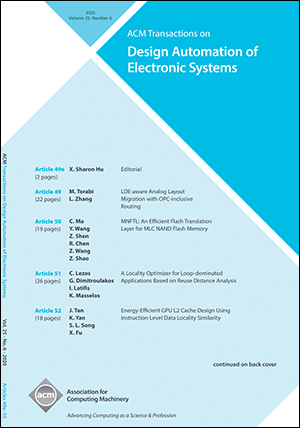Colin C. McAndrew, Andries J. Scholten, Kiran K. Gullapalli, Yogesh Chauhan, and Kejun Xia
Benchmarks for SPICE Modeling and Parameter Extraction Based on AI/ML
IEEE Transactions on Electron Devices (2025)
DOI: 10.1109/TED.2025.3537952
1 Computer Engineering, Iowa State University, (USA)
2 NXP Semiconductors N.V., Eindhoven (NL)
3 NXP Semiconductors N.V., Austin (USA)
4 IIT Kanpur, (IN)
5 TSMC, Hsinchu (TW)
Abstract: Over the past decades, the number of submitted articles that use numerical approaches for SPICE models or for characterization (extraction) of parameters of existing SPICE models has grown significantly. Many of those articles rely on synthetic data, generated either from technology computer-aided design (TCAD) or from physical SPICE model simulations; most do not model/fit measured data. Furthermore, those articles do not evaluate the physical correctness, smoothness/monotonicity, or asymptotic correctness of the approach they propose. That is sufficient for initial evaluation of proposed techniques. However, it does not prove that they are “industrial strength.” This article presents benchmarks/guidelines for the proposed artificial intelligence (AI)/machine learning (ML) SPICE modeling and characterization techniques to try to help them become practical and useful.
TAB: CHECKLIST FOR MODELS
| Capability |
Existing State-of-the-Art |
Proposed AI/ML Approach |
Best Prior AI/ML Approach |
| obeys the laws of thermodynamics |
✓ |
? |
? |
| accurate DC modeling for all terminal currents, on relevant log/linear scale |
✓ |
? |
? |
| accurate capacitance/charge modeling |
✓ |
? |
? |
| models DC and capacitance interaction where relevant |
✓ |
? |
? |
| accurate modeling of high-frequency/non-quasi-static effects where relevant |
✓ |
? |
? |
| works for large-signal transient simulation, including delay effects |
✓ |
? |
? |
| accurate noise modeling |
✓ |
? |
? |
| has full geometry dependence |
✓ |
? |
? |
| has complete temperature dependence |
✓ |
? |
? |
| models all necessary LDEs |
✓ |
? |
? |
| behaves “well” for unreasonable geometry or temperature or bias |
✓ |
? |
? |
| exhibits physical monotonicity over bias, geometry, and temperature |
✓ |
? |
? |
| is smooth (ideally C∞-continuous) |
✓ |
? |
? |
| exhibits relevant physical symmetries (currents, charges, their derivatives) |
✓ |
? |
? |
| exhibits asymptotic correctness over geometry, temperature, and bias |
✓ |
? |
? |
| includes modeling of electrothermal effects (with frequency dependence) |
✓ |
? |
? |
| includes, or enables, modeling of global and local statistical variation |
✓ |
? |
? |
| includes, or enables, modeling of aging |
✓ |
? |
? |
| enables modeling of parasitics for different layouts |
✓ |
? |
? |
| is verified to converge reliably in at least one circuit simulator |
✓ |
? |
? |

 Advances in machine learning (ML) over the past half-dozen years have revolutionized the effectiveness of ML for a variety of applications. However, design processes present challenges that require parallel advances in ML and CAD as compared to traditional ML applications such as image classification. This seeks original submission on ML applications to the entire design flow of integrated circuits, from system-level design to manufacturing, from functional verification to testing, from design time to runtime, etc.
Advances in machine learning (ML) over the past half-dozen years have revolutionized the effectiveness of ML for a variety of applications. However, design processes present challenges that require parallel advances in ML and CAD as compared to traditional ML applications such as image classification. This seeks original submission on ML applications to the entire design flow of integrated circuits, from system-level design to manufacturing, from functional verification to testing, from design time to runtime, etc.-1.png?width=1200&upscale=true&name=OSSummit%20Europe%202025%20-%20CFP%20Open%20(1)-1.png)










